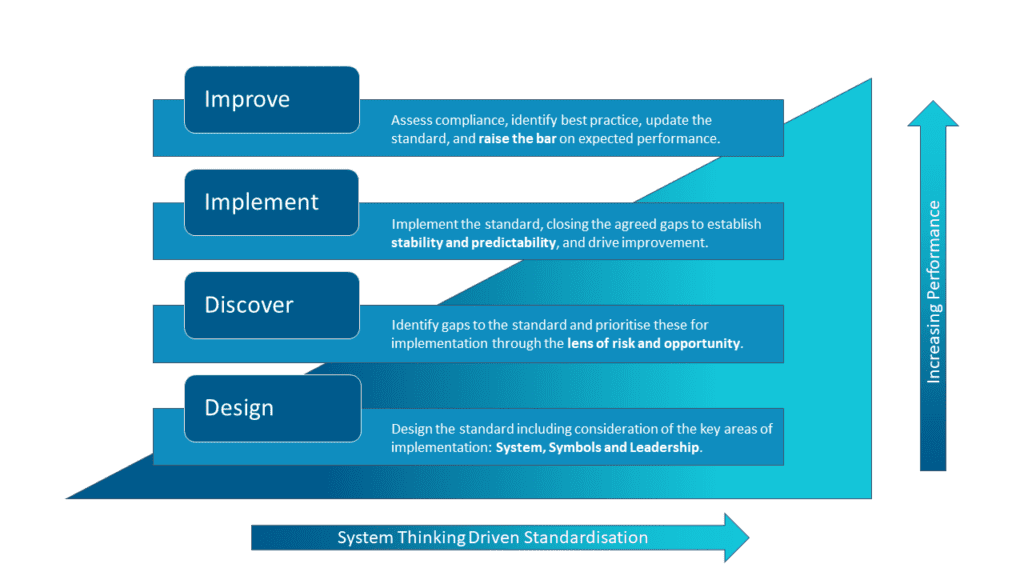The value of standards
Love them or hate them, standards are here to stay. And love them we should, as although there seems to be an endless number of them, standards are an essential aspect of ensuring effective business governance. The reason standards are fundamental to effective business governance is they are developed to address known risks and opportunities (often learnt the hard way). They are an essential part of our business knowledge base and guidance on how to make our businesses safer and more productive – increasing stability and predictability in what we do. Their role in effective governance can therefore not be under-estimated; however, the way we implement these may not always give us the value we are looking for (but more on that later in this series).

Standards through the lens of risk and opportunity
Fatal Hazard Standards, for example, are developed based on mitigating the known contributing factors that have been found to cause fatalities or serious life-changing injuries. They define the requirements – that implemented – are our controls for these factors. These standards are the guide for the site or area-specific risk and opportunity assessment that addresses the context-specific factors which may not be identified in the “vanilla-flavoured” standard. Standards and their requirements must be considered in the frame of reference of the site or area. The point of the exercise is not simply to tick the box by taking what was applied elsewhere and rebadging for the new purpose without stopping to think about what is relevant for the current situation. We must stop and think – how does this standard apply to us? How will we meet the intent of the standard rather than just compliance?
Implementing standards is not about tick and flick
Before embarking on implementation there are four key considerations:
- Why is this important in the current context? What is the value? Are we ready for this change?
- How will this integrate with our existing ways of work? We must apply a system thinking approach initially before addressing the individual pieces.
- Who do we need to engage on this journey? Stakeholders, stakeholders, stakeholder, say it again, stakeholders.
- What do we need to put in place to make our improvements stick? As we will talk to in a later blog, we need to address three key areas of System, Symbols and Leadership.
And as we considered the improvements to implement our standard, never forget to take the time to look for those opportunities to streamline and improve the efficiency of the existing processes/practices. It is often these improvements that will give you and your team the time back to incorporate additional requirements, unlock additional value, and make the implementation a success.
Assessing standards must put leadership and behaviours under the spotlight
Assessing to the relevant standards is our mechanism to ensure the controls are in place and identify those improvement actions we need to take to achieve compliance and meet the intent of the standard. For the intent of the standard to be achieved this assessment is rarely ever a documentation focus only. Every management system standard will include leadership and behavioural aspects as to achieve the intent. It is not sufficient to have only an artefact (i.e., the plan, procedure, or form); we must also demonstrate that the use of the artefact is baked into our rituals, routines, and culture (“but do we believe it? ”). The artefact may tick the box (“here’s one I prepared earlier – just for your visit”); but it maketh not the management system and it sure won’t meet the intent of the standard by itself.
Fear not the non-conformance
What about non-conformances? Do we need to close every gap at once? For some standards – as per the example above – the requirements are mandatory, as industry bodies or regulators have long realised that this requirement mitigates an unacceptable risk. In this case, we have no choice but to show full compliance or our actions to achieve this compliance over a reasonable time horizon. For other standards where the requirements are “should” (type B requirement in ISO-speak), the choice to implement is based on value. However, when we speak of value this should be a consideration of both risk and opportunity rather than a reflection on does this add immediately to the bottom line (i.e., opportunity only).
Create your own virtuous cycle
This is a challenge we face with many clients implementing requirements for internal or external standards with the familiar comment “we’re not doing it unless it adds value”. This is an entirely appropriate comment so long as we put some boundaries on it:
- Value must weigh both risk and opportunity – 80% of what we do tends to be risk mitigation which can be notoriously difficult to value.
- Value should be attributed to the sum of the requirements without nit-picking every requirement in detail.
- Non-conformances should be assessed and explanation as to why it is not required provided.
- Standards are not shopping lists that we pick and choose – a small number of exceptions might be acceptable; however, a larger number should be a red flag.
So, let’s all learn to love standards and use these to drive real value in our businesses by implementing them in a way that is not just to tick a box. And remember, standards are about improvement. Keep them live, update them over time, raise the bar, re-assess, and create your own virtuous cycle.
Next in our series we will be blogging about integrated management systems (IMS) and how these are constructed to be whole of business (yes, there’s more to an IMS than safety and environment). Until then, be Prediktable!
def: Prediktable = a state of management Zen where all our routine (boring) tasks are automated and we spend more time innovating, strategizing, engaging our teams and delivering predictably great outcomes.
